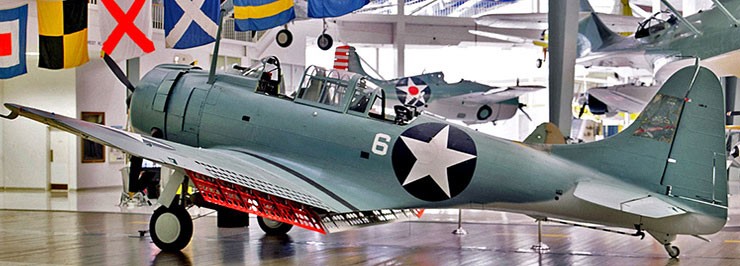SBD Dauntless BuNo 2106

Low (PNG, 319x319px, 106KB)
Med (JPEG, 1280x1280px, 73KB)
This one-of-a-kind SBD Dauntless, Bureau Number 2106, is a survivor of the attack on Pearl Harbor and participated in dive bombing runs against a Japanese carrier during the pivotal Battle of Midway, making it one of the most historic aircraft in existence. Throughout World War II, the Dauntless proved a highly effective dive bomber with the Marine Corps, its unique split flap/dive brake allowing for very steep and accurate diving attacks (70 degrees). Dauntlesses accounted for the sinking of four Japanese carriers at Midway, turning the tide of the Pacific War.
A refined version of Northrop's BT-1 dive bomber that had been developed in 1935, the prototype SBD was actually a BT-1 that had undergone numerous structural and engine changes, and was redesignated the XBT-2. The new aircraft, built at Northrop's El Segundo plant, which had become a division of Douglas Aircraft, evolved into Douglas' famous Dauntless dive bomber.
In April 1939 orders were placed for 57 SBD-1s and 87 SBD-2s, the former for the Marines, the latter to go to the Navy. The SBD-2 had increased fuel capacity and was armed with two .30-in. machine guns in the engine cowling and either one or two .30-in. machine guns in the rear cockpit. By spring 1941, the SBD-3 appeared, incorporating self-sealing fuel tanks, extra armor and two .50-in. guns in the cowling. One important improvement was to the hydraulic system, improving dive brake operation. By December 1941, 584 SBD-3s had been sent to Navy and Marine squadrons.
Capable of delivering a 1,000 lb. bomb, the SBD's steep dive bombing attack was devastating to ship targets, as was amply demonstrated during the Battle of Midway in June 1942. In a matter of minutes SBDs sank three Japanese carriers and heavily damaged a fourth that was attacked again and sunk the following day. Called the "Speedy Dee" by its pilots, the Dauntless established a reputation for ruggedness and reliability.
The SBD-2 on display, Bureau Number 2106, is the only known surviving aircraft from the Midway battle, assigned to Marine Scout Bombing Squadron (VMSB) 241. Earlier, it survived the Pearl Harbor attack while assigned to an aircraft pool on Ford Island, and served in Bombing Squadron (VB) 2 aboard the carrier Lexington (CV-2), taking part in raids on Lae and Salamaua, New Guinea, in early 1942.
SPECIFICATIONS
| Manufacturer: | Douglas Aircraft Company |
| Type: | Carrier-based scout/dive bomber |
| Crew: | Pilot and observer/aerial gunner |
| Powerplant: | One 1,000 horsepower Wright R-1820-52 engine |
| Dimensions: | Length: 32 ft., 8 in. |
| Weight: | Empty: 6,345 lb. |
| Performance: | Max Speed: 250 mph |
| Armament: | Two .50-in. forward firing guns; two .30-in. rear guns; 1,200 lb. ordnance under fuselage and 325 lb. under wings |
- Aviation
- Photograph
- Image (gif, jpg, tiff)


